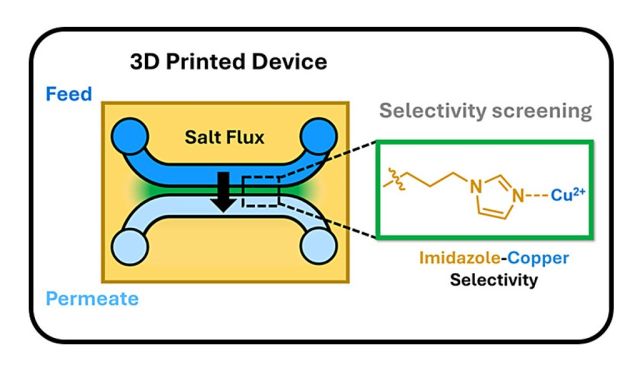
3D Printing of Functional Hydrogel Devices for Screenings of Membrane Permeability and Selectivity
Isabel Arias Ponce, Rahul Sujanani, Joshua D. Moon, Juan Manuel Urueña, Craig J. Hawker, Rachel A. Segalman
ACS Appl. Polym. Mater. Dec. 2024
Abstract: Developing a fundamental understanding of the effects of varying ligand chemistries on mass transport rates is key to designing membranes with solute-specific selectivity. While permeation cells offer a robust method to characterize membrane performance, they are limited to assessing a single membrane chemistry or salt solution per test. As a result, investigating the effects of varying ligand chemistries on membrane performance can be a tedious process, involving both the preparation of multiple samples and numerous, time-consuming permeation tests. This study uses digital light processing (DLP) 3D printing to fabricate a millifluidic flow-based permeation device made from a hydrogel active ester network that can be easily functionalized with ion-selective ligands. Without the need for bonding or assembly steps, ligands can be introduced and tested in the permeation device by simply injecting a small volume of a ligand solution. Various salt concentrations and molecular species can be cycled through a single device by switching the solution feeding into the salt reservoir, thereby reducing the number of samples needed for permeability and selectivity screenings. This research sets the groundwork for formulation development and postprocessing methods to 3D-print functional millifluidic devices capable of assessing solute selectivity in membranes and polymer adsorbents for aqueous separations. In this work, comparable salt permeability trends were observed with both 3D-printed devices and traditional assays. Devices were functionalized with an imidazole ligand to investigate salt permeability and selectivity of monovalent and divalent salts. Measurements showed increasing permeability for monovalent salts (NaCl) relative to divalent salts (MgCl2, CuCl2) in functionalized membranes, with higher monovalent/divalent selectivity at increasing imidazole grafting densities. The methods and findings described here represent a step toward developing higher-throughput methods with 3D-printed devices for screening the effects of ligand chemistry on mass transport rates in membrane materials.